KERN & SOHN ABJ 320-4NM User Manual

KERN & Sohn GmbH
Ziegelei 1 |
Phone: +49-[0]7433- 9933-0 |
D-72336 Balingen |
Fax: +49-[0]7433-9933-149 |
email: info@kern-sohn.com |
Internet: www.kern-sohn.com |
Operating instructions
Analytical balance
KERN ABS-N_ABJ-NM
Version 1.2
03/2013
GB
ABS-N_ABJ-NM-BA -e-1312
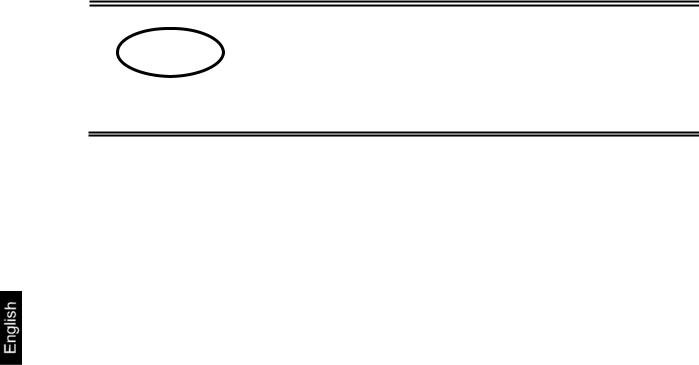
|
|
KERN ABS-N_ABJ-NM |
|
|
GB |
Version 1.2 03/2013 |
|
|
|
Operating instructions |
|
|
|
Analytical balance |
|
Table of Contents |
|
|
|
1 |
Technical Specifications............................................................................... |
4 |
|
2 |
Declaration of conformity ............................................................................. |
7 |
|
3 |
Appliance overview ....................................................................................... |
8 |
|
3.1 |
Keyboard overview................................................................................................................... |
9 |
|
3.1.1 |
Numeric entry ........................................................................................................................... |
|
10 |
3.2 |
Overview of displays.............................................................................................................. |
11 |
|
4 |
Basic Information (General)........................................................................ |
12 |
|
4.1 |
Proper use............................................................................................................................... |
|
12 |
4.2 |
Improper Use........................................................................................................................... |
|
12 |
4.3 |
Warranty .................................................................................................................................. |
|
12 |
4.4 |
Monitoring of Test Resources............................................................................................... |
13 |
|
5 |
Basic Safety Precautions ............................................................................ |
13 |
|
5.1 |
Pay attention to the instructions in the Operation Manual ................................................ |
13 |
|
5.2 |
Personnel training |
.................................................................................................................. |
13 |
6 |
Transportation & Storage............................................................................ |
13 |
|
6.1 |
Testing upon acceptance ...................................................................................................... |
13 |
|
6.2 |
Packaging / return transport ................................................................................................. |
14 |
|
7 |
Unpacking, Setup and Commissioning ..................................................... |
16 |
|
7.1 |
Installation Site, Location of Use.......................................................................................... |
16 |
|
7.2 |
Unpacking and checking ....................................................................................................... |
16 |
|
7.2.1 |
Scope of delivery / serial accessories....................................................................................... |
17 |
|
7.2.2 |
Placing ...................................................................................................................................... |
|
18 |
7.3 |
Mains connection ................................................................................................................... |
|
19 |
7.3.1 |
Turning On the Power............................................................................................................... |
19 |
|
7.4 |
Initial Commissioning ............................................................................................................ |
19 |
|
7.5 |
Connection of peripheral devices......................................................................................... |
19 |
|
8 |
Adjustment ................................................................................................... |
|
20 |
8.1 |
Automatic adjustment by PSC (Perfect Self Calibration), only models ABJ .................... |
20 |
|
8.2 |
Menu settings „I.CAL“ / „E.CAL“ .......................................................................................... |
23 |
|
8.2.1 |
Adjustment with internal weight (KERN ABJ) ........................................................................... |
24 |
|
8.2.2 |
Adjustment with external weight (KERN ABS).......................................................................... |
25 |
|
8.3 |
Adjustment log........................................................................................................................ |
|
26 |
8.4 |
Balance identification no. ...................................................................................................... |
27 |
|
9 |
Verification ................................................................................................... |
|
28 |
10 |
Weighing....................................................................................................... |
|
30 |
10.1 |
Switch-on balance / call-up weighing mode........................................................................ |
30 |
|
10.2 |
Switch off the balance............................................................................................................ |
30 |
|
10.3 |
Set the start display................................................................................................................ |
31 |
|
10.4 |
Auto Power-Off function (automatic switch-off function) .................................................. |
33 |
|
10.5 |
Simple weighing ..................................................................................................................... |
|
34 |
10.6 |
Taring....................................................................................................................................... |
|
35 |
10.7 |
Switch-over weighing unit..................................................................................................... |
36 |
|
2 |
|
ABS-N_ABJ-NM-BA -e-1312 |
|

10.7.1 |
Freely programmable weighing unit ..................................................................................... |
37 |
10.7.2 |
Change position of decimal dot for freely programmable weighing unit............................... |
38 |
10.7.3 |
Input minimum weight for freely programmable weighing unit............................................. |
38 |
10.8 |
Change readability (1D/10D).................................................................................................. |
39 |
10.9 |
Display decimal dot as point or comma............................................................................... |
40 |
11 |
Menu ............................................................................................................. |
41 |
11.1 |
Menu symbol........................................................................................................................... |
41 |
11.2 |
Navigation in the menu.......................................................................................................... |
42 |
11.3 |
Menu overview........................................................................................................................ |
43 |
11.4 |
Resetting the menu ................................................................................................................ |
44 |
11.5 |
Menu Lock............................................................................................................................... |
45 |
11.5.1 |
Change password ................................................................................................................ |
46 |
11.6 |
Log menu settings.................................................................................................................. |
47 |
12 |
Zero / tare menu (zeroing and taring functions) ....................................... |
48 |
12.1 |
Zero tracking function............................................................................................................ |
49 |
12.2 |
Auto zero function.................................................................................................................. |
50 |
12.3 |
Auto Tare function.................................................................................................................. |
51 |
12.4 |
Zero / tare timing change function........................................................................................ |
52 |
13 |
Settings for Stability and Response........................................................... |
53 |
13.1 |
Stability and reaction settings via „Easy Setting display“ (without invoking menu)...... |
53 |
13.2 |
Selection weighing / dosing mode ....................................................................................... |
54 |
13.3 |
Standstill width ....................................................................................................................... |
55 |
14 |
Application Functions ................................................................................. |
57 |
14.1 |
Parts counting ........................................................................................................................ |
57 |
14.2 |
Percent determination............................................................................................................ |
60 |
14.2.1 |
Reference weight = 100 % ................................................................................................... |
61 |
14.2.2 |
User-defined reference ........................................................................................................ |
62 |
14.2.3 |
Percent determination .......................................................................................................... |
63 |
14.3 |
Formula mode......................................................................................................................... |
64 |
14.3.1 |
Enable edition „component no.“ ........................................................................................... |
66 |
14.3.2 |
Enable issue „TOTAL“.......................................................................................................... |
67 |
15 |
Check weighing and target mode (check and target weighing) .............. |
68 |
15.1 |
Check weighing ...................................................................................................................... |
68 |
15.2 |
Target mode ............................................................................................................................ |
72 |
16 |
Data output................................................................................................... |
75 |
16.1 |
Pin connection........................................................................................................................ |
75 |
16.2 |
Issue functions ....................................................................................................................... |
76 |
16.2.1 |
Automatic data output / Auto Print function.......................................................................... |
76 |
16.2.2 |
Continuous Output function.................................................................................................. |
78 |
16.2.3 |
Output Timing Change function ........................................................................................... |
80 |
16.2.4 |
GLP Output function / balance identification number........................................................... |
81 |
16.3 |
Communication parameters .................................................................................................. |
82 |
16.3.1 |
Selection of a standard setting „MODE 1 - MODE 5“........................................................... |
83 |
16.3.2 |
User-defined settings „MODE U“ / setting for KERN –YKB-01N......................................... |
84 |
16.4 |
Data Formats........................................................................................................................... |
88 |
16.5 |
Remote control instructions.................................................................................................. |
92 |
17 |
Service, maintenance, disposal.................................................................. |
93 |
17.1 |
Cleaning................................................................................................................................... |
93 |
17.2 |
Service, maintenance............................................................................................................. |
95 |
17.3 |
Disposal................................................................................................................................... |
95 |
18 |
Instant help................................................................................................... |
95 |
18.1 |
Error messages....................................................................................................................... |
96 |
ABS-N_ABJ-NM-BA-e-1312 |
3 |

1 Technical Specifications
KERN |
ABJ |
|
|
ABJ |
|
|
ABJ |
|
ABJ |
|
80-4NM |
|
|
120-4NM |
|
|
220-4NM |
|
320-4NM |
|
|
|
|
|
|
|
|
|
|
Readability (d) |
0.1 mg |
|
|
0.1 mg |
|
|
0.1 mg |
|
0.1 mg |
|
|
|
|
|
|
|
|
|
|
Weighing range (max) |
80 g |
|
|
120 g |
|
|
220 g |
|
320 g |
|
|
|
|
|
|
|
|
|
|
Minimum load (Min) |
10 mg |
|
|
10 mg |
|
|
10 mg |
|
10 mg |
|
|
|
|
|
|
|
|
|
|
Verification value (e) |
1 mg |
|
|
1 mg |
|
|
1 mg |
|
1 mg |
|
|
|
|
|
|
|
|
|
|
Verification class |
I |
|
|
I |
|
|
I |
|
I |
|
|
|
|
|
|
|
|
|
|
Reproducibility |
0.2 mg |
|
|
0.2 mg |
|
|
0.2 mg |
|
0.2 mg |
|
|
|
|
|
|
|
|
|
|
Linearity |
± 0.3 mg |
|
|
± 0.3 mg |
|
|
± 0.3 mg |
|
± 0.3 mg |
|
|
|
|
|
|
|
|
|
|
Stabilization time |
|
|
|
3 sec. |
|
||||
|
|
|
|
|
|
|
|
||
Adjustment weight |
|
|
|
internal |
|
||||
|
|
|
|
|
|
|
|
|
|
Warm-up time |
4 h |
|
|
8 h |
|
|
8 h |
|
8 h |
|
|
|
|
|
|
|
|
|
|
Weighing Units |
mg, g |
|
|
|
|
|
mg, g, ct |
|
|
|
|
|
|
|
|
|
|
|
|
Smallest part weight for |
|
|
|
|
1 mg |
|
|||
piece counting |
|
|
|
|
|
||||
|
|
|
|
|
|
|
|
|
|
Reference quantities at |
|
5, 10, 20, 50,100 |
|
|
|||||
piece counting |
|
|
|
||||||
|
|
|
|
|
|
|
|
|
|
Weighing plate, stainless |
|
|
|
ø 91mm |
|
||||
steel |
|
|
|
|
|||||
|
|
|
|
|
|
|
|
|
|
Dimensions of the housing |
|
|
|
210 x 340 x 325 |
|
||||
(B x D x H) [mm] |
|
|
|
|
|||||
|
|
|
|
|
|
|
|
|
|
Dimensions |
|
174 x 162 x 227 (weighing space) |
|
||||||
Glass wind screen [mm] |
|
|
|||||||
|
|
|
|
|
|
|
|
|
|
Net weight (kg) |
|
|
|
|
6 |
|
|
|
|
|
|
|
|
|
|
|
|
|
|
Permissible |
|
|
|
+10° C bis +30° C |
|
||||
ambient condition |
|
|
|
|
|||||
|
|
|
|
|
|
|
|
|
|
Humidity of air |
|
20 ~ 85 % relative (not condensing) |
|||||||
|
|
|
|
||||||
AC adapter (Primary) |
|
AC 100 -240 V, 400 mA 50/60Hz |
|
||||||
|
|
|
|
|
|
||||
Rated electric power supply |
|
|
|
DC 12 V, 1.25 A |
|
||||
|
|
|
|
|
|
|
|
||
Pollution Degree |
|
|
|
|
2 |
|
|
||
|
|
|
|
|
|
||||
Overvoltage Category |
|
|
|
Category II |
|
||||
|
|
|
|
|
|
||||
Altitude |
|
|
|
Up to 2000 m |
|
||||
|
|
|
|
||||||
Installation Site |
|
device may only be used indoors |
|
||||||
|
|
|
|
|
|
|
|
|
|
4 |
ABS-N_ABJ-NM-BA -e-1312 |

|
KERN |
|
|
ABS 80-4N |
|
|
ABS 120-4N |
|
|
|
|
|
|
|
|
|
|
|
Readability (d) |
|
|
0.1 mg |
|
|
0.1 mg |
|
|
|
|
|
|
|
|
|
|
|
Weighing range (max) |
|
|
80 g |
|
|
120 g |
|
|
|
|
|
|
|
|
|
|
|
Reproducibility |
|
|
0.2 mg |
|
|
0.2 mg |
|
|
|
|
|
|
|
|
|
|
|
Linearity |
|
|
± 0.3 mg |
|
|
± 0.3 mg |
|
|
|
|
|
|
|
|
|
|
|
Recommended adjusting |
|
|
80 g (E2) |
|
|
100 g (E2) |
|
|
weight not supplied (class) |
|
|
|
|
|
||
|
|
|
|
|
|
|
|
|
|
Warm-up time |
|
|
4 h |
|
|
8 h |
|
|
|
|
|
|
|
|
|
|
|
Stabilization time |
|
|
|
3 sec. |
|
||
|
|
|
|
|
|
|
|
|
|
Weighing Units |
|
|
mg, g |
|
|
mg, g, ct |
|
|
|
|
|
|
|
|
|
|
|
Smallest part weight for |
|
|
|
1 mg |
|
||
|
piece counting |
|
|
|
|
|||
|
|
|
|
|
|
|
|
|
|
Reference quantities at |
|
5, 10, 20, 50,100 |
|
||||
|
piece counting |
|
|
|||||
|
|
|
|
|
|
|
|
|
|
Weighing plate, stainless |
|
|
|
ø 91mm |
|
||
|
steel |
|
|
|
|
|||
|
|
|
|
|
|
|
|
|
|
Dimensions of the housing |
|
|
|
210 x 340 x 325 |
|
||
|
(B x D x H) [mm] |
|
|
|
|
|||
|
|
|
|
|
|
|
|
|
|
Dimensions |
|
|
174 x 162 x 227 (weighing space) |
|
|||
|
Glass wind screen [mm] |
|
|
|
||||
|
|
|
|
|
|
|
|
|
|
Net weight (kg) |
|
|
|
6 |
|
|
|
|
|
|
|
|
|
|
|
|
|
Permissible |
|
|
|
+5° C to +40° C |
|
||
|
ambient condition |
|
|
|
|
|||
|
|
|
|
|
|
|
|
|
|
Humidity of air |
|
|
20 ~ 85 % relative (not condensing) |
|
|||
|
|
|
|
|
|
|||
|
AC adapter (Primary) |
|
|
AC 100 -240 V, 400 mA 50/60Hz |
|
|||
|
|
|
|
|
|
|
||
|
Rated electric power supply |
|
|
|
DC 12 V, 1.25 A |
|
||
|
|
|
|
|
|
|
|
|
|
Pollution Degree |
|
|
|
2 |
|
|
|
|
|
|
|
|
|
|
||
|
Overvoltage Category |
|
|
|
Category II |
|
||
|
|
|
|
|
|
|
||
|
Altitude |
|
|
|
Up to 2000 m |
|
||
|
|
|
|
|
|
|||
|
Installation Site |
|
|
device may only be used indoors |
|
|||
|
|
|
|
|
|
|
|
|
ABS-N_ABJ-NM-BA-e-1312 |
5 |

|
KERN |
|
|
ABS 220-4N |
|
|
ABS 320-4N |
|
|
|
|
|
|
|
|
|
|
|
Readability (d) |
|
|
0.1 mg |
|
|
0.1 mg |
|
|
|
|
|
|
|
|
|
|
|
Weighing range (max) |
|
|
220 g |
|
|
320 g |
|
|
|
|
|
|
|
|
|
|
|
Reproducibility |
|
|
0.2 mg |
|
|
0.2 mg |
|
|
|
|
|
|
|
|
|
|
|
Linearity |
|
|
± 0.3 mg |
|
|
± 0.3 mg |
|
|
|
|
|
|
|
|
|
|
|
Recommended adjusting |
|
|
200 g (E2) |
|
|
300 g (E2) |
|
|
weight not supplied (class) |
|
|
|
|
|
||
|
|
|
|
|
|
|
|
|
|
Stabilization time |
|
|
|
3 sec. |
|
||
|
|
|
|
|
|
|
||
|
Warm-up time |
|
|
|
8 h |
|
||
|
|
|
|
|
|
|
||
|
Weighing Units |
|
|
|
mg, g, ct |
|
||
|
|
|
|
|
|
|
|
|
|
Smallest part weight for piece |
|
|
|
1 mg |
|
||
|
counting |
|
|
|
|
|||
|
|
|
|
|
|
|
|
|
|
Reference quantities at |
|
5, 10, 20, 50,100 |
|
||||
|
piece counting |
|
|
|||||
|
|
|
|
|
|
|
|
|
|
Weighing plate, stainless |
|
|
|
ø 91mm |
|
||
|
steel |
|
|
|
|
|||
|
|
|
|
|
|
|
|
|
|
Dimensions of the housing (B |
|
|
210 x 340 x 325 |
|
|||
|
x D x H) [mm] |
|
|
|
||||
|
|
|
|
|
|
|
|
|
|
Dimensions |
|
|
174 x 162 x 227 (weighing space) |
|
|||
|
Glass wind screen [mm] |
|
|
|
||||
|
|
|
|
|
|
|
|
|
|
Net weight (kg) |
|
|
|
6 |
|
|
|
|
|
|
|
|
|
|
|
|
|
Permissible |
|
|
|
+5° C to +40° C |
|
||
|
ambient condition |
|
|
|
|
|||
|
|
|
|
|
|
|
|
|
|
Humidity of air |
|
|
20 ~ 85 % relative (not condensing) |
|
|||
|
|
|
|
|
|
|||
|
AC adapter (Primary) |
|
|
AC 100 -240 V, 400 mA 50/60Hz |
|
|||
|
|
|
|
|
|
|
||
|
Rated electric power supply |
|
|
|
DC 12 V, 1.25 A |
|
||
|
|
|
|
|
|
|
|
|
|
Pollution Degree |
|
|
|
2 |
|
|
|
|
|
|
|
|
|
|
||
|
Overvoltage Category |
|
|
|
Category II |
|
||
|
|
|
|
|
|
|
||
|
Altitude |
|
|
|
Up to 2000 m |
|
||
|
|
|
|
|
|
|||
|
Installation Site |
|
|
device may only be used indoors |
|
|||
|
|
|
|
|
|
|
|
|
6 |
ABS-N_ABJ-NM-BA -e-1312 |

2 Declaration of conformity
KERN & Sohn GmbH
D-72322 Balingen-Frommern |
Phone: 0049-[0]7433-9933-0 |
Postbox 4052 |
Fax: 0049-[0]7433-9933-149 |
email: info@kern-sohn.de |
Internet: www.kern-sohn.de |
Declaration of conformity
EC-Konformitätserklärung ECDéclaration de conformité
EC-Dichiarazione di conformità ECDeclaração de conformidade EC-Deklaracja zgodności
EC-Declaration of -Conformity EC-Declaración de Conformidad EC-Conformiteitverklaring
ECProhlášení o shode EC-Заявление о соответствии
EN |
Konformitäts- |
Wir erklären hiermit, dass das Produkt, auf das sich diese Erklärung bezieh |
||||
|
erklärung |
mit den nachstehenden Normen übereinstimmt. |
||||
GB |
Declaration of |
We hereby declare that the product to which this declaration refers conforms |
||||
|
conformity |
to the following standards. |
||||
CZ |
Prohlášení o |
Tímto prohlašujeme, že výrobek, kterého se toto prohlášení týká, je vsouladu |
||||
|
shode |
s níže uvedenými normami. |
||||
E |
Declaración de |
Manifestamos en |
la |
presente que el producto eal sequ refiere es |
||
|
conformidad |
declaración está de acuerdo con las normas siguientes |
||||
F |
Déclaration de |
Nous déclarons avec cela responsabilité que le produit, auquel se rapporte l |
||||
|
conformité |
présente déclaration, est conforme aux normes citées ci-après. |
||||
I |
Dichiarazione di Dichiariamo con |
ciò |
che il prodotto al quale la presente dichiarazi |
|||
|
conformitá |
riferisce è conforme alle norme di seguito citate. |
||||
NL |
Conformiteit- |
Wij verklaren hiermede dat het product, waarop deze verklaring betrekk |
||||
|
verklaring |
heeft, met de hierna vermelde normen overeenstemt. |
||||
P |
Declaração de |
Declaramos por meio da presente que o produto no qual se refer |
||||
|
conformidade |
declaração, corresponde às normas seguintes. |
||||
PL |
Deklaracja |
Niniejszym oświadczamy, że produkt, którego niniejsze oświadczenie dotyczy, |
||||
|
zgodności |
jest zgodny z poniższymi normami. |
||||
RUS |
Заявление о |
Мы заявляем, что продукт, к которому относится данная декларация, |
||||
соответствии |
соответствует перечисленным ниже нормам. |
|||||
Electronic Balance: KERN ABJ-NM, ABS-N |
||||||
|
|
|
|
|
|
|
EU Directive |
|
Standards |
|
|
|
|
|
|
|
|
|
||
2004/108/EC |
|
EN 61326-1:2006 |
|
|
||
|
|
|
|
|
||
2006/95/EC |
|
EN 61010-1: 2010 |
|
|
||
|
|
|
|
|
|
|
Datum |
|
27.03.2013 |
|
|
|
|
Date |
|
|
|
|
Signatur |
|
|
|
|
|
|
||
Ort der Ausstellung |
72336 Balingen |
|
Signature |
|||
|
|
Albert Sauter |
||||
Place of issue |
|
|
|
|
KERN & Sohn GmbH |
|
|
|
|
|
|
|
Geschäftsführer |
|
|
|
|
|
|
Managing director |
KERN & Sohn GmbH, Ziegelei 1, D-72336 Balingen, Tel. +49-[0]7433/9933-0
Fax +49-[0]7433/9933-149, E-Mail: info@kern-sohn.com, Internet: www.kern-sohn.com
ABS-N_ABJ-NM-BA-e-1312 |
7 |
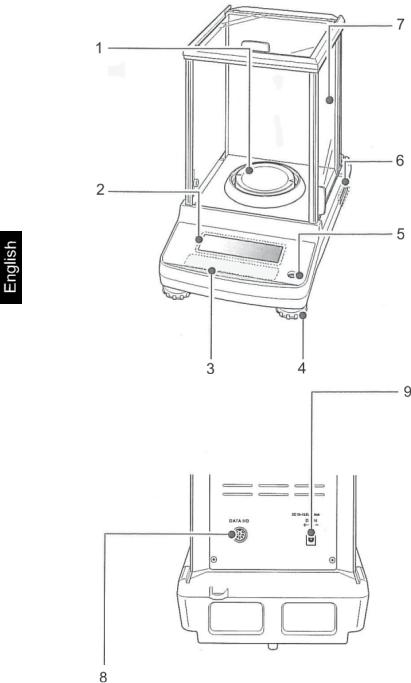
3 Appliance overview
1. Weighing plate
2. Display
3. Keyboard
4. Levelling screw
5. Bubble level
6. Name plate
7. Wind protection
8. Appliance interface
9. Mains adapter connection
8 |
ABS-N_ABJ-NM-BA -e-1312 |
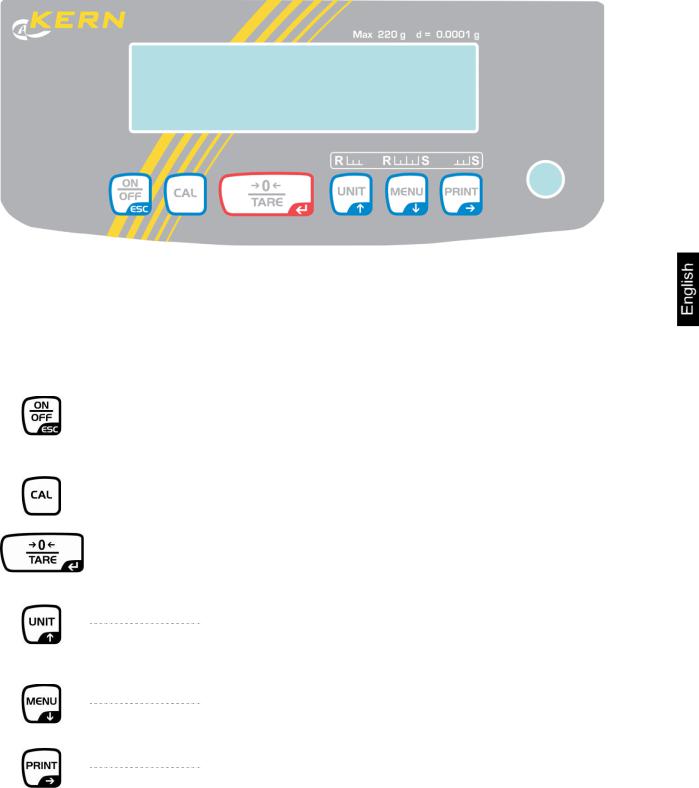
3.1Keyboard overview
In menu:
Key |
Designation: |
|
|
|
|
Function |
|
|
|
Pressed once and |
|
|
Keep pressed for |
|
In menu |
||
|
|
|
released |
|
|
about 3 seconds |
|
|
|
|
|
|
|
|
|
||
|
|
|
|
|
|
|
|
Menu item back. |
|
|
|
Switches between |
|
|
|
Return to weighing |
|
|
ON/OFF |
|
|
|
|
mode: |
||
|
|
the operation a |
- |
|
||||
|
|
|
Press ON/OFF |
|||||
|
|
|
standby modes. |
|
|
|
||
|
|
|
|
|
|
repeatedly or for 3 s. |
||
|
|
|
|
|
|
|
|
|
|
|
|
|
|
|
|
|
Cancel procedure |
|
CAL |
|
Start adjustment |
Invoke calibration |
|
- |
||
|
|
menu |
|
|||||
|
|
|
|
|
|
|
||
|
|
|
|
|
|
|
|
|
|
TARE |
|
Tare or set weight |
|
Invoke zero / tare |
|
Confirm entry |
|
|
|
display to zero |
|
menu |
|
|||
|
|
|
|
|
|
|||
|
|
|
|
|
|
|
||
|
UNIT |
Switch-over |
|
|
|
|
||
|
weighing unit. |
|
Invoke unit setting |
|
Scroll forward in |
|||
|
|
|
Display stored |
|
|
|||
|
|
|
|
menu. |
|
menu |
||
|
Navigation key |
|
reference weight |
|
|
|||
|
|
|
|
|
|
|||
|
|
|
(PCS, %). |
|
|
|
|
|
|
MENU |
|
|
|
|
Switch over |
|
Invoke main menu |
|
|
|
|
|
weighing mode / |
|
(press twice) |
|
|
|
|
|
|
|
|
||
|
Navigation key |
|
|
|
|
application mode |
|
Scroll backwards in |
|
|
|
|
|
|
|
menu |
|
|
|
|
|
|
|
|
|
|
|
|
Calculate weighing |
|
Invoke Data Output |
|
Select next menu |
||
|
|
|
|
|
||||
|
Navigation key |
|
data via interface |
|
menu |
|
item. |
|
|
|
|
|
|
|
|
|
|
|
|
|
|
|
|
|
|
|
ABS-N_ABJ-NM-BA-e-1312 |
9 |
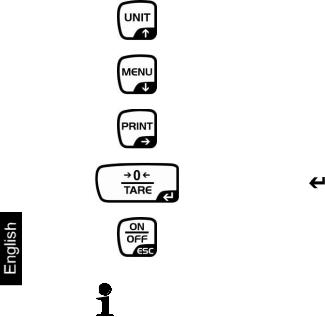
3.1.1Numeric entry
Key |
Designation: |
|
Function |
|
|
|
|
|
|
|
Navigation key |
|
Increase flashing digit |
|
|
Shift flashing decimal dot to the left |
|
||
|
|
|
|
|
|
|
|
|
|
|
Navigation key |
|
Decrease flashing digit |
|
|
Shift flashing decimal dot to the right |
|
||
|
|
|
|
|
|
|
|
|
|
|
Navigation key |
Digit selection to the right |
|
|
|
|
|
|
|
|
Navigation key |
|
Confirm entry |
|
|
|
|
|
|
|
ESC |
|
Cancel input |
|
|
|
|
|
|
With numerical input the indicator [#] appears.
10 |
ABS-N_ABJ-NM-BA -e-1312 |
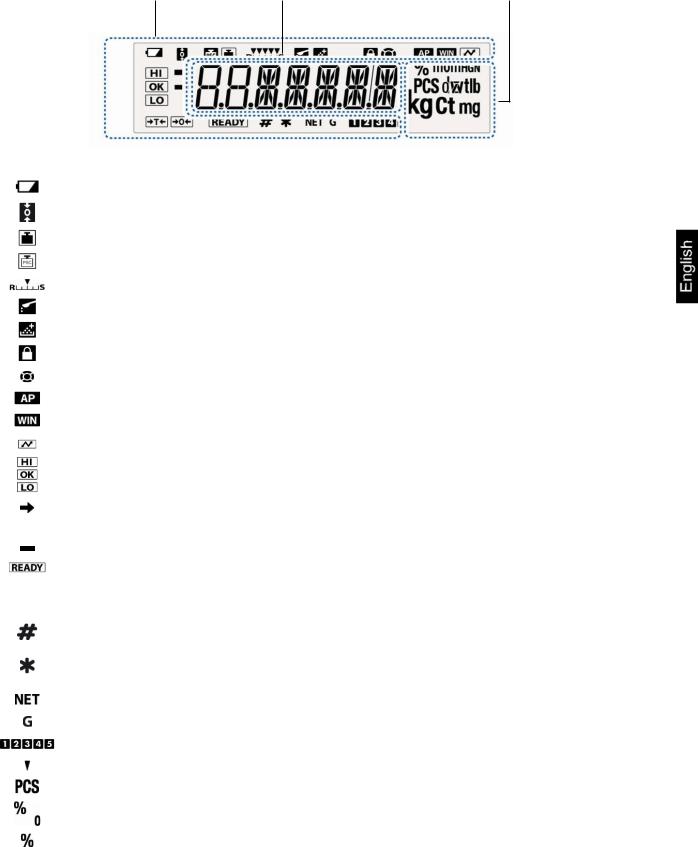
3.2Overview of displays
Symbols |
|
Numerical display/menu |
|
Units |
|
|
|
|
|
Display |
Description |
see chpt. |
|
|
|
|
Battery symbol |
|
|
|
|
|
Zero tracking function active |
+ Chpt.12.1 |
|
|
|
|
Displays adjustment |
+ Chpt. 8.2.1 |
|
|
|
|
Flashes prior to start of automatic adjustment, only models ABJ |
+ Chpt. 8.1 |
|
|
|
|
Stability and reaction settings via „Easy Setting display“ |
+ Chpt.13.1 |
|
|
|
|
Balance is in dosing mode (pouring mode) |
+ Chpt. 13.2 |
|
|
|
|
Balance is in formula mode |
+ Chpt. 14.3 |
|
|
|
|
Menu lock active |
+ Chpt. 11.5 |
|
|
|
|
Menu symbol |
+ Chpt. 11.2 |
|
|
|
|
Auto Print function active |
+ Chpt. 16.2.1 |
|
|
|
|
Not documented |
|
|
|
|
|
Log menu settings |
|
|
|
|
|
Tolerance marks in check weighing and target mode |
+ Chpt. 15 |
|
|
|
|
The stability display indicates that the weighing value is stable. |
|
|
Highlights current setting in the menu. |
|
|
|
|
|
Negative weighed value |
|
|
|
|
|
Stand-by mode |
+ Chpt. 10.2 |
|
+ Chpt. 14.3 |
|
|
Ready for start formulation |
|
|
Ready for start continuous data output („MANU ON“) |
+ Chpt. 16.5.2 |
|
|
|
|
|
|
|
Indicates numeric value entry. |
+ Chpt. 3.1.1 |
|
|
|
|
Shows the stored reference in piece number or percent determination mode. |
+ Chpt.14.1 |
|
+ Chpt.14.2.3 |
|
|
|
|
|
Net weight in formula mode |
+ Chpt. 14.3 |
|
|
|
|
Total weight (TOTAL) of all components in formula mode |
+ Chpt. 14.3 |
|
|
|
|
Memory space piece weight |
+ Chpt.14.1 |
|
|
|
|
Change position decimal dot for freely programmable weighing unit |
+ Chpt.10.7.2 |
|
|
|
|
Balance is in piece counting mode |
+ Chpt.14.1 |
|
|
|
|
Balance is in percent determination mode with user-defined reference weight |
+ Chpt.14.2.1 |
|
|
|
|
Balance is in percent determination mode, reference weight =100% |
+ Chpt.14.2.2 |
|
|
|
ABS-N_ABJ-NM-BA-e-1312 |
11 |

4 Basic Information (General)
4.1Proper use
The balance you purchased is intended to determine the weighing value of material to be weighed.It is intended to be used as a “nonautomatic“- balance, i.e. the material to be weighed is manually and carefully placed in the centre of the weighing plate. As soon as a stable weighing value is reached the weighing value can be read.
4.2Improper Use
Do not use balance for dynamic addonweighing procedures, if small amounts of goods to be weighed are removed or added. The “stability compensation“ installed in the balance may result in displaying an incorrect measuring value!(Example: Slowly draining fluids from a container on the balance.)
Do not leave permanent load on the weighing Thisplate. may damage the measuring system.
Impacts and overloading exceeding the stated maximum load (max) of the balance, minus a possibly existing tare load, must be strictly avoidedBalance. may be damage by this.
Never operate balance in explosive environment.The serial version is not explosion protected.
The structure of the balance may not be modifiedThis. may lead to incorrect weighing results, safety-related faults and destruction of the balance.
The balance may only be used according to the described conditions.Other areas of use must be released by KERN in writing.
4.3Warranty
Warranty claims shall be voided in case
•Our conditions in the operation manual are ignored
•The appliance is used outside the described use
•The appliance is modified or opened
•Mechanical damage or damage by media, liquids, natural wear and tear
•The appliance is improperly set up or incorrectly electrically connected
•The measuring system is overloaded
12 |
ABS-N_ABJ-NM-BA -e-1312 |

4.4Monitoring of Test Resources
In the framework of quality assurance the measuring-related properties of the balance and, if applicable, the testing weight, must be checked regularlyThe . responsible user must define a suitable interval as well as type and scope of this test. Information is available on KERN’s home pagewww(.kern-sohn.com with regard to the monitoring of balance test substances and the test weights required for this. In KERN’s accredited DKD calibration laboratory test weights and balances may
be calibrated (return to the national standard) fast and at moderate cost.
5 Basic Safety Precautions
5.1Pay attention to the instructions in the Operation Manual
Carefully read this operation manual before setup and commissioning, even if you are already familiar with KERN balances.
5.2Personnel training
The appliance may only be operated and maintained by trained personnel.
6 Transportation & Storage
6.1Testing upon acceptance
When receiving the appliance, please check packaging immediately, and the appliance itself when unpacking for possible visible damage.
ABS-N_ABJ-NM-BA-e-1312 |
13 |

6.2Packaging / return transport
Keep all parts of the original packaging for a possibly required return.
Only use original packaging for returning.
Prior to dispatch disconnect all cables and remove loose/mobile parts.
Reattach possibly supplied transport securing devices.
Secure all parts such as the glass wind screen, the weighing platform, power unit etc. against shifting and damage.
14 |
ABS-N_ABJ-NM-BA -e-1312 |
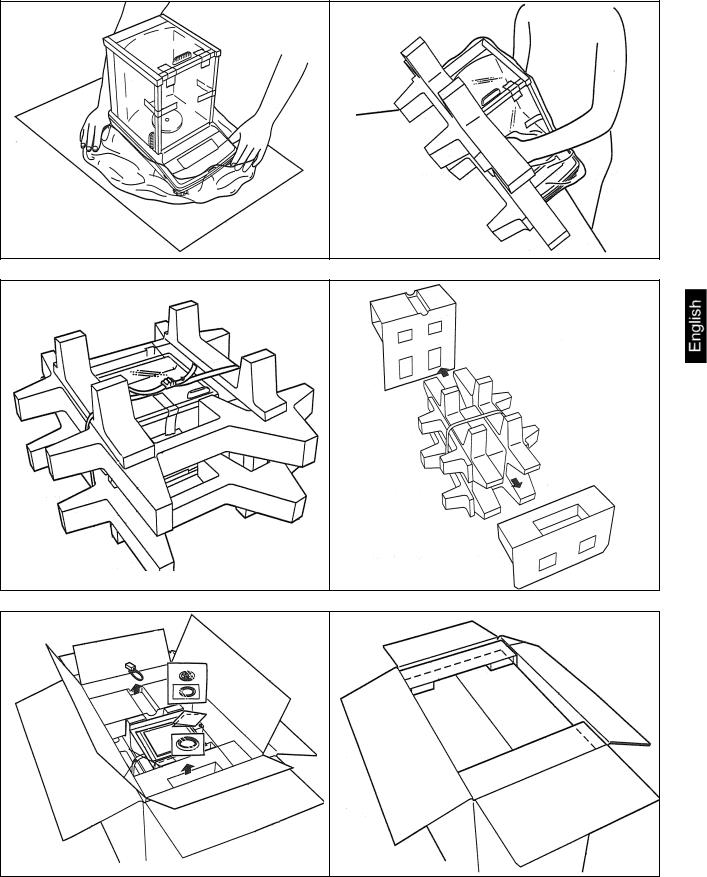
ABS-N_ABJ-NM-BA-e-1312 |
15 |

7 Unpacking, Setup and Commissioning
7.1Installation Site, Location of Use
The balances are designed in a way that reliable weighing results are achieved in common conditions of use.
You will work accurately and fast, if you select the right location for your balance.
Therefore, observe the following for the installation site:
•Operate the device only indoors.
•Place the balance on a firm, level surface;
•Avoid extreme heat as well as temperature fluctuation caused by installing next to a radiator or in the direct sunlight;
•Protect the balance against direct draughts due to open windows and doors;
•Avoid jarring during weighing;
•Protect the balance against high humidity, vapours and dust;
•Do not expose the device to extreme dampness for longer periods of time. Non-permitted condensation (condensation of air humidity on the appliance) may occur if a cold appliance is taken to a considerably warmer environment.
In this case, acclimatize the disconnected appliance for ca. 2 hours at room temperature.
•Avoid static charge of goods to be weighed or weighing container.
If electro-magnetic fields or static charge occur, or if the power supply is unstable major deviations on the display (incorrect weighing results) are possible. In that case, the location must be changed.
7.2Unpacking and checking
Open package, take out the appliance and accessoriesVerify. that there has been no damage and that all packing items are present.
16 |
ABS-N_ABJ-NM-BA -e-1312 |
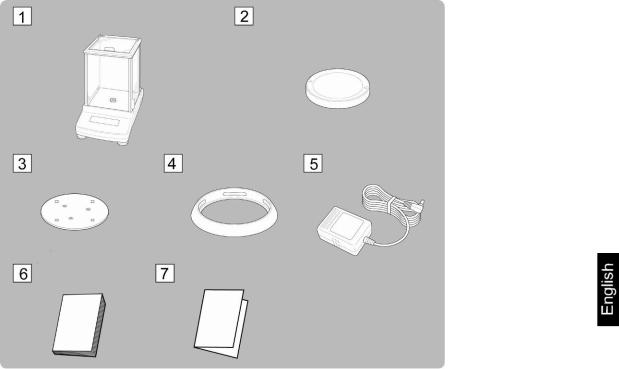
7.2.1 Scope of delivery / serial accessories
1.Balance
2.Weighing plate
3.Carrier weighing plate
4.Screening ring
5.Mains adapter
6.Operating instructions
7.Menu overview
ABS-N_ABJ-NM-BA-e-1312 |
17 |
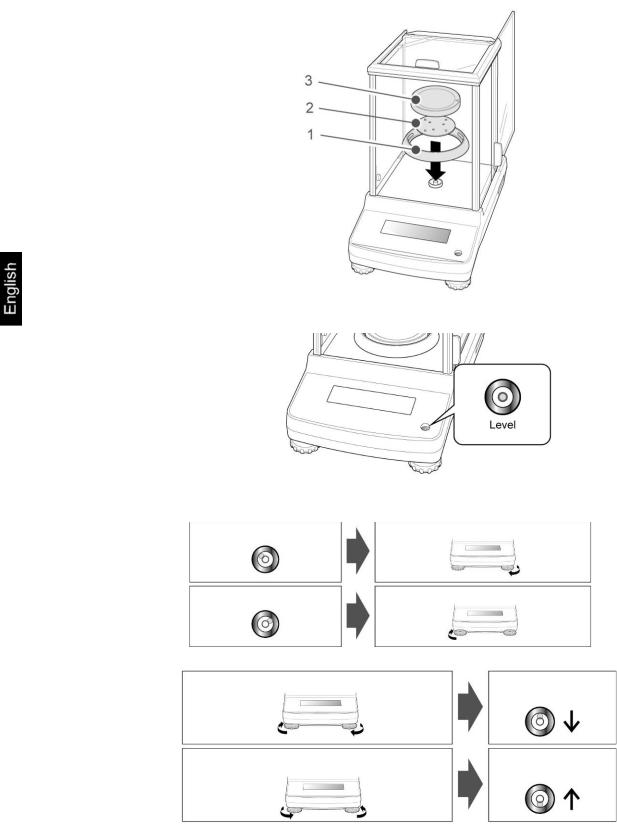
7.2.2 Placing
Attach circular screen, carrier of weighing plate and weighing plate in order.
Level balance with foot screws until the air bubble of the water balance is in the prescribed circle.
Check levelling regularly
18 |
ABS-N_ABJ-NM-BA -e-1312 |

7.3Mains connection
Power is supplied via the external mains adapter. The stated voltage value must be the same as the local voltage.
Only use original KERN mains adapters. Using other makes requires consent by
KERN.
7.3.1 Turning On the Power
Supply power to balance via mains adapter. The display lights up and the balance carries out a selftest.
In the ABJ models an automatic adjustment takes place.
The selftest is completed when „OFF“ appears on the display.
7.4Initial Commissioning
In order to obtain exact results with the electronic balances, your balance must have reached the operating temperature (see warming up time chpt. 1). During this warming up time the balance must be connected to the power supply (mains, accumulator or battery).
The accuracy of the balance depends on the local acceleration of gravity. Strictly observe hints in chapter Adjustment.
7.5Connection of peripheral devices
Before connecting or disconnecting of additional devices (printer, PC) to the data interface, always disconnect the balance from the power supply.
With your balance, only use accessories and peripheral devices by KERN, as they are ideally tuned to your balance.
ABS-N_ABJ-NM-BA-e-1312 |
19 |

8 Adjustment
As the acceleration value due to gravity is not the same at every location on earth, each balance must be coordinated - in compliance with the underlying physical weighing principle - to the existing acceleration due to gravity at its place of location (only if the balance has not already been adjusted to the location in the factory). This adjustment process must be carried out for the first commissioning, after each change of location as well as in case of fluctuating environment temperature. To receive accurate measuring values it is also recommended to adjust the balance periodically in weighing operation.
Observe stable environmental conditions. A warming up time (see chapter 1) is required for stabilization. Ensure that there are no objects on the weighing plate.
8.1Automatic adjustment by PSC (Perfect Self Calibration), only models ABJ
The default setting for balances of the series ABJ prompts automatic adjustment via the PSC function (cannot be switched off).
The moment a change in temperature is detected this function uses the internal tare weight to carry out fully-automatic adjustment with the help of a temperature sensor. Adjustment in weighing mode is carried out automatically under the following conditions:
(1)When there is a change in the surrounding temperature (∆t 2°C)
(2)When about four hours has passed since the previous calibration.
(3)When the balance is switched from standby status to weighing mode and condition (1) or (2) has been met.
If one of the above conditions was met in weighing mode, the weight symbol  flashes for about two minutes in order to notify the pending adjustment;
flashes for about two minutes in order to notify the pending adjustment;
20 |
ABS-N_ABJ-NM-BA -e-1312 |

Case 1: The load on the weighing plate is near zero.
The weight symbol  flashes for approx. two minutes, followed by „PSC.RUN“.
flashes for approx. two minutes, followed by „PSC.RUN“.
After that the internal adjustment is started automatically. In order to ensure proper PSC operation, prevent vibrations and air flow.
As soon as the display in grams reappears after completing adjustment via PSC, the balance returns to weighing mode.
ABS-N_ABJ-NM-BA-e-1312 |
21 |

Case 2: Weighing plate loaded
The gram display flashes for two minutes, followed by „PLS.CAL“.
Unload weighing plate. The gram display flashes again for 2 minutes; after that the internal adjustment is started automatically. In order to ensure proper PSC operation, prevent vibrations and air flow.
As soon as the display in grams reappears after completing adjustment via PSC, the balance returns to weighing mode.
To prevent a start-up of adjustment during a measuring process, actuate the
ON/OFF button as soon as „PLS.CAL“ is displayed. The gram display flashes again for two minutes, followed by „PLS.CAL“.
22 |
ABS-N_ABJ-NM-BA -e-1312 |

8.2Menu settings „I.CAL“ / „E.CAL“
To invoke the adjustment function in weighing mode, press CAL for 3 sec.
Acknowledge using PRINT, the current setting is displayed.
Select the desired adjustment using the navigation keys
( )
I.CAL: Adjustment with internal weight (see chpt.
8.1)
E.CAL: Adjustment with external weight (see chpt.
8.2)
Confirm with TARE
Press ON/OFF repeatedly or 3 sec., the balance will return into weighing mode
The saved adjustment (I.CAL or E.CAL) can now directly be invoked via the
CAL button.
ABS-N_ABJ-NM-BA-e-1312 |
23 |
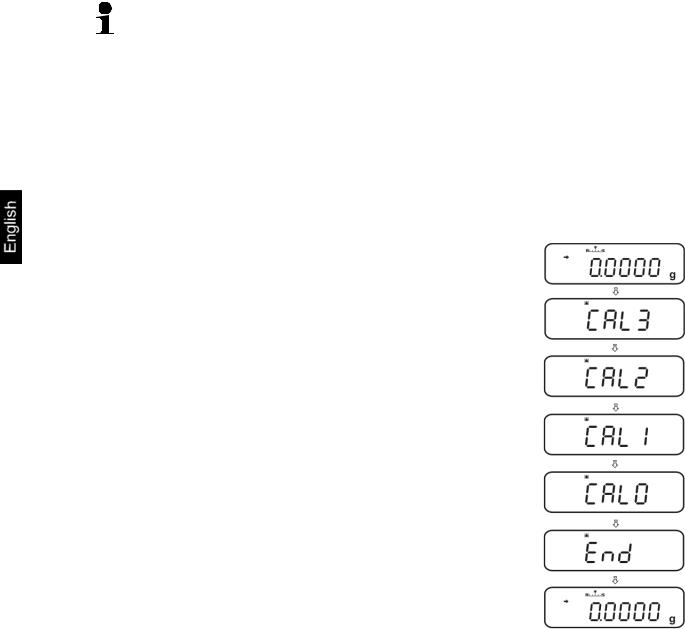
8.2.1 Adjustment with internal weight (KERN ABJ)
With the internal adjustment weight, the weighing accuracy can be checked and readjusted at any time.
• Condition: Menu setting „I.CAL“.
•When an optional printer is connected and the GLP function activat
while starting the adjustment logWAIT„ “ will be displayedAfter. the printout the adjustment will be continued automatically.
•Adjustment may be interrupted with ON/OFF, „ABORT“ is displayed.
Press the CAL-button and adjustment will take place automatically.
The indicator  will be shown.
will be shown.
After successful adjustment the balance automatically returns to weighing mode.
In case of an adjustment error (e.g. objects on the weighing plate) the display will show an error message, repeat adjustment.
When an optional printer is connected and the GLP function is connected, the adjustment log will be edited, see chpt. 8.3.
24 |
ABS-N_ABJ-NM-BA -e-1312 |

8.2.2 Adjustment with external weight (KERN ABS)
• Condition: Menu setting „E.CAL“.
•The weight to be used depends on the capacity of the scale. Carry out adjustment as near as possible to the balance’s maximum weight (recommended adjustment weight see chpt. 1). Weights of different nominal values or tolerance classes may be used for adjustment but are not optimal for technical measuring. The accuracy of the adjustment weight must correspond approximately to or, if possible, be better than, the readability of the balance.
Minimum weight „Adjustment weight“:
ABS 80-4N / ABS 120-4N : 50 g ABS 220-4N / ABS 320-4N:100 g
Information about test weights you will find in the internet under: http://www.kern-sohn.com
•When an optional printer is connected and the GLP function activate while starting the adjustment logWAIT„ “ will be displayed.After the printout the adjustment process will be continued automatically.
•If during the adjustment process within 60 s no operation is carried out „ERR C“ will be displayed. Press ON/OFF a restart.
In weighing mode press CAL. The weight value of the recommended adjustment weight (see chpt. 1) appears flashing. The indicator  will be shown.
will be shown.
If the value shall be changed, press MENU, the active digit flashes.
Carry out the desired setting using navigation buttons (see chapter 3.1.1 „Numeric input“).
With flashing adjustment weight display, place the adjustment weight carefully on the center of the weighing plate within 60 s. Close wind screen doors completely.
Wait until the zero display flashes.
Take away the adjustment weight and close the wind screen doors. After successful adjustment the balance automatically returns to weighing mode.
In case of an adjustment error (e.g. objects on the weighing plate) the display will show an error message, repeat adjustment.
When an optional printer is connected and the GLP function is connected, the adjustment log will be edited, see chpt. 8.3.
ABS-N_ABJ-NM-BA-e-1312 |
25 |

8.3Adjustment log
This function enables automatic log issue after each adjustment. These logs may be issued by using an optional printer.
Printout example (KERN YKB-01N):
-- - - - - - - - - - - - - - - -
CAL –EXTERNAL
-- - - - - - - - - - - - - - - -
KERN & Sohn GmbH
TYPE ABJ 220-4NM
SN WBIIAB000I ID 1234
REF 200.0000g
BFR 200.0001g
AFT 200.0000g
-COMPLETE
-SIGNATURE-
- - - - - - - - - - - - - - - - -
Mode of adjustment
Company
Model
Serial no.
Balance identification no. (see chpt. 8.4)
Used adjustment weight
Before adjustment
After adjustment
prepared by
Make sure that the communication parameter of balance and printer are the same.
Call function
In weighing mode press the CAL key for 3 sec.
Use the navigation buttons ( ) to select „GLP.OUT“. The current setting is marked by the stability display ( )
)
With stability display ( ) |
Function activated |
Without stability display ( ) |
Function disabled |
26 |
ABS-N_ABJ-NM-BA -e-1312 |

How to change settings
Press TARE
Press ON/OFF repeatedly or for 3 sec., the balance will return into weighing mode
8.4Balance identification no.
This setting is for the balance ID number that is output along with the adjustment report.
Call up menu
In weighing mode press the MENU button twice
Select menu item
Press the navigation buttons ( ) repeatedly until „TOOLS“ is displayed.
Confirm with PRINT
Press the navigation buttons ( ) repeatedly until „SYSTEM“ is displayed.
Confirm with PRINT
Press the navigation buttons ( ) repeatedly until „BAL.ID“ is displayed.
Press TARE, the currently set ID no. is displayed (factory setting 0000).
Enter balance identification no. (max. 4 characters)
Enter the desired ID no. using navigation buttons (see chapter 3.1.1 „Numeric input“).
Press ON/OFF repeatedly or 3 sec., the balance will return into weighing mode
ABS-N_ABJ-NM-BA-e-1312 |
27 |
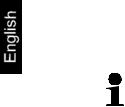
9 Verification
General introduction:
According to EU directive 90/384/EEC or 2009/23EG balances must be officially verified if they are used as follows (legally controlled area):
a)For commercial transactions if the price of goods is determined by weighing.
b)For the production of medicines in pharmacies as well as for analyses in the medical and pharmaceutical laboratory.
c)For official purposes
d)For manufacturing final packages
In cases of doubt, please contact your local trade in standard.
Verification notes:
An EU type approval exists for balances described in their technical data as verifiable. If a balance is used where obligation to verify exists as described above, it
must be verified and re-verified at regular intervals.
Re-verification of a balance is carried out according to the respective national regulations. The validity for verification of balances in Germany is e.g. 2 years. The legal regulation of the country where the balance is used must be observed!
Verification of the balance is invalid without the seal.
The seal marks attached on verified balances point out that the balance may only be opened and serviced by trained and authorised specialist staff. If the seal mark is destroyed, verification looses its validity. Please observe all national laws and legal regulations. In Germany a re-verification will be necessary.
28 |
ABS-N_ABJ-NM-BA -e-1312 |
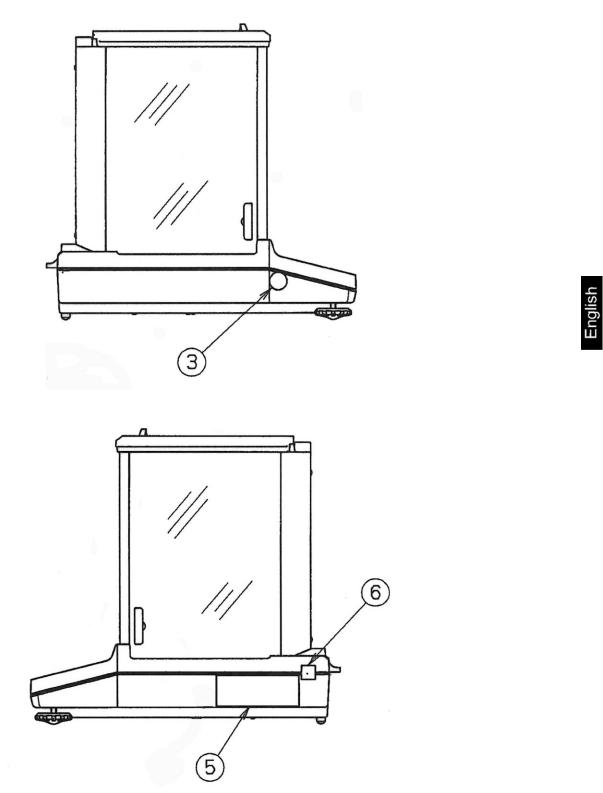
Position of seals
Seal
Data plate Seal
ABS-N_ABJ-NM-BA-e-1312 |
29 |
